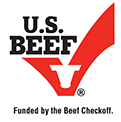USMEF Conference Opens with Focus on Differentiation, Long-Term Investment
Emphasizing the quality and consistency of U.S. red meat is the key to expanding the international customer base, according to the impressive lineup of opening day speakers on Wednesday at the U.S. Meat Export Federation (USMEF) Spring Conference in Kansas City. USMEF members from throughout the nation also learned about additional resources available to promote American beef, pork, and lambb in emerging markets through USDA’s new Regional Agricultural Promotion Program (RAPP).

USMEF President and CEO Dan Halstrom followed with an update on year-to-date export results
USMEF President and CEO Dan Halstrom followed with an update on year-to-date export results for U.S. beef, pork, and lamb. On the pork side, Halstrom explained that while shipments to leading market Mexico are on a record pace, U.S. pork is achieving broad-based growth in several regions. Halstrom noted that first quarter export value ($2.1 billion) equated to more than $64 per hog slaughtered, while March exports averaged nearly $71 per head.
USMEF Chair Randy Spronk, a pork and grain producer from Edgerton, Minn., welcomed attendees with a reminder of how critical free trade agreements (FTAs) have been in creating global opportunities for the U.S. red meat industry.
While they are not full-blown FTAs, Spronk also praised the market access gains achieved in the U.S.-China Phase One Economic and Trade Agreement and the U.S.-Japan Agreement.
March was also a great month for U.S. beef export value, which equated to nearly $455 per head of fed slaughter. The first quarter average was $408, up 9% from a year ago, which Halstrom said was a very encouraging metric.
Guest speaker Randy Blach, CEO of CattleFax, echoed these sentiments in explaining how U.S. beef competes for the consumer dollar, both in the U.S. and internationally.
Blach also gave an update on the U.S. cattle industry’s herd rebuilding efforts. He noted that the U.S. herd is not yet in expansion mode, but liquidation has slowed, and the herd size has stabilized. He cautioned that even when expansion does materialize, it will not mirror the previous expansion cycle.
As for expanding exports, Blach stressed the need for patience and persistence in developing new markets.
Daniel Whitley, administrator of USDA’s Foreign Agricultural Service, praised USMEF members for their productivity gains while also providing an update on RAPP funding allocations. He highlighted RAPP’s goal of helping U.S. exporters expand their customer base beyond traditional and established markets, focusing on regions such as Africa, Latin America, and Southeast Asia.
Whitley noted that RAPP places a specific emphasis on Africa, which is projected to hold 25% of the world’s population by 2050. That same year, the planet’s total population is expected to reach 10 billion, which presents a massive food production challenge.
USMEF members also received unique insights about global food security issues from Kip Tom, former U.S. ambassador to the United Nations for Food and Agriculture. Ambassador Tom stressed that our national security is dependent on our food security, and he too emphasized the need to embrace production technologies.
While Tom believes the U.S. must pay close attention to the global trade advances made by major agricultural competitors, he shares the opinion that an emphasis on quality will differentiate U.S. products and lead to continuing opportunities for American agriculture.
Source: USMEF

